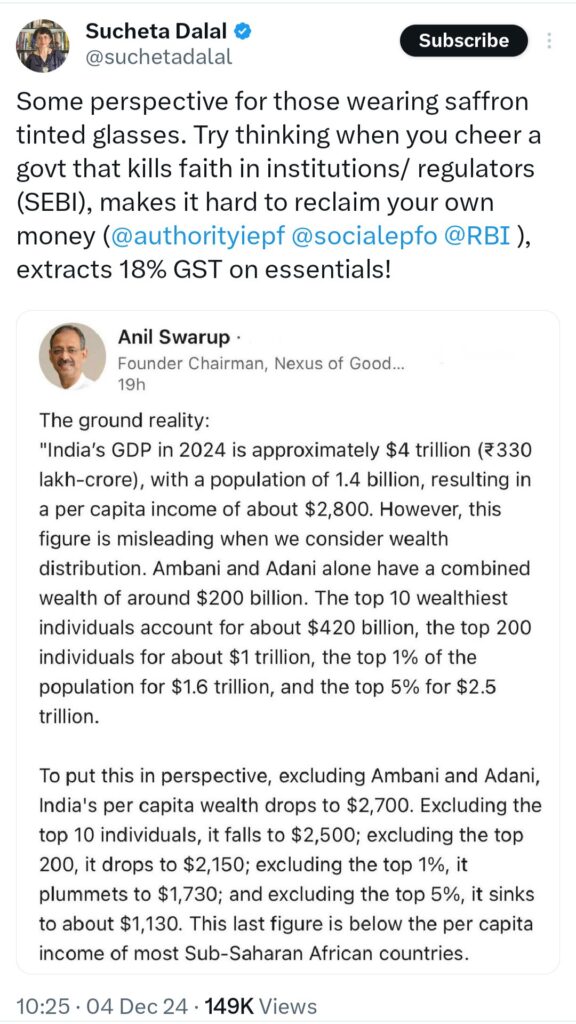
A social media post by Anil Swarup, former IAS officer and Founder Chairman of Nexus of Good, has sparked controversy for its flawed portrayal of wealth distribution in India. His analysis, which attempted to highlight disparities in wealth concentration, was amplified by financial journalist Sucheta Dalal before she later deleted her comments. Critics have slammed the post as a striking example of financial misunderstanding and have rebutted its methodology in detail.
The Claim
Anil Swarup stated that India’s GDP in 2024 stands at approximately $4 trillion (₹330 lakh crore), with a per capita income of $2,800 for a population of 1.4 billion. He argued that this figure is misleading when factoring in wealth concentration among the richest individuals.
He claimed that:
- Mukesh Ambani and Gautam Adani collectively hold $200 billion in wealth.
- The top 10 wealthiest individuals account for $420 billion.
- The top 200 individuals hold $1 trillion.
- The top 1% of the population controls $1.6 trillion, and the top 5% hold $2.5 trillion.
Swarup suggested excluding these groups would drastically lower India’s per capita wealth. For example:
- Excluding Ambani and Adani reduces per capita wealth to $2,700.
- Excluding the top 10 wealthiest individuals lowers it to $2,500.
- Removing the top 1% brings it to $1,730.
- Excluding the top 5% reduces it further to $1,130, which Swarup compared to the per capita income of Sub-Saharan African countries.
What Is The Truth?
Critics dismissed Anil Swarup’s claims as fundamentally flawed. They pointed out the following issues:
Conflation of Wealth and Income
Swarup’s analysis conflated GDP per capita—an income measure of economic output per person—with wealth, which represents accumulated assets over time. They argued that such a conflation is a basic error that renders his conclusions invalid.
Irrelevant Wealth Exclusions
Excluding the wealth of individuals like Ambani and Adani from GDP per capita calculations was deemed statistically and conceptually incorrect. GDP is the sum of all goods and services produced in a country, and individual wealth has no bearing on GDP per capita figures.
Exaggerating Inequality
Critics noted that while wealth inequality exists in every economy, Swarup’s focus on the richest segments without examining median or average wealth skewed the perspective. This approach, they argued, sensationalized inequality without providing an accurate picture of societal well-being.
Flawed Redistribution Logic
Critics also rejected the implicit assumption that excluding the wealthiest individuals would evenly redistribute wealth among the population. They highlighted that wealth distribution is governed by complex economic mechanisms, such as investments and productivity, which Swarup’s simplistic analysis ignored.
I would have dismissed this analysis as a joke till someone pointed out that the author is @anilswarup58, former secretary in GoI. His post is flawed for the following reasons:
1.Confusing Wealth and Income
•GDP per capita measures income (the economic output per person), not… pic.twitter.com/pxg6r13tFY— Amit Malviya (@amitmalviya) December 4, 2024
Amplification By Sucheta Dalal
Sucheta Dalal, a financial journalist and frequent government critic, quoted Swarup’s analysis, adding her commentary (in a now deleted post):
“Some perspective for those wearing saffron-tinted glasses. Try thinking when you cheer a government that kills faith in institutions/regulators (SEBI), makes it hard to reclaim your own money, [and] extracts 18% GST on essentials.”
Dalal’s post quickly attracted backlash, with critics accusing her of endorsing an ill-conceived analysis that conflates basic economic metrics. Observers mocked her for failing to differentiate between wealth and GDP, which they argued should be elementary knowledge for a financial journalist. Dalal subsequently deleted the post, but not before sparking a wider debate.

The episode drew comparisons to viral social media miscalculations, such as claims that dividing a billionaire’s wealth among citizens would make everyone rich. Critics argued that Swarup’s analysis fell into the same category of oversimplified reasoning.
In conclusion, the debate has exposed fundamental misunderstandings of economic principles and highlighted the risks of amplifying flawed analyses by influential individuals. The incident underscores the need for diligence and accuracy when discussing economic inequality in public forums.
Subscribe to our channels on Telegram, WhatsApp, and Instagram and get the best stories of the day delivered to you personally.




